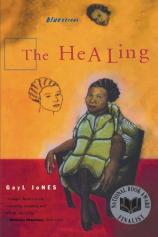Reading Group Guide
Discussion Questions
The Healing (Bluestreak Series)

1. "What's it they usedta call women like you? A adventuress? A color-girl adventuress," Joan says of Harlan (p. 232). What sort of woman is Joan? Is she similar or dissimilar to Harlan? What qualities do Joan and Harlan share throughout their separa te and collaborated adventures?
2. At times, Harlan sounds prophetic: "Seem like most people turn they own flaws of character into virtues. They see other people's flaws, but they own flaws, they turn into virtues" (p. 46). Do you agree with Harlan's insight? Does Jones use the narr ator as an avenue for her own"preaching"?
3. Harlan heals people without the use of modern western medicine. Her practice has an audience of stout believers and stanch skeptics. Are readers meant to believe in Harlan's "powers"? Do you?
4. Consider the unicorn story (p. 136) and the turtle woman story (pp. 135, 164, 221, 281). What do these stories say about appearances and reality? About personal healing and transformation? How do they relate to Harlan? How do they relate to you?
5. "Whenever you're about to do something mean or disrespectful to someone imagine they're Christ, she'd say, and then decide how to treat them. . . . So, among some, she got the reputation for being a good and wise woman. Among others, she was consider ed a fool and a pushover" (p. 129). What is your position on Harlan"s mother's philosophy?
6. Do you find the narrator's exploration of abstract ideas distracting or enhancing to the flow of the story? Why do you think it's such a large part of the book?
7. Carolina, the Italian woman, says,"All women all over the world are just pawns in a man's game" (p. 237). Norvelle says that men and women are natural enemies (p. 258). Do you agree/disagree with either of the claims? Did you find yourself reacting strongly toward any comments on gender?
8. Jones explains the origins of Maine's black population (p. 183). Were you aware of this before reading The Healing? Can you find other passages in which Jones challenges your beliefs about race?
9. Jones gives us an extensive reading list on page 247. Why? What information does she want us to take from these titles? In the 23 November 1998 issue of The Nation, Tom LeClair writes,"We hear a lot more about books than music in the novel. Maybe Big Music stands for Big Publishing. And is it 'healing' or 'heeling,' or both? Does the novelist heel to lowest-common-denominator expectations 'to accessible sentimentality' in order to disquiet from within?" How would you respond to the quest ions LeClair raises?
10. Joan says, "But I knew the true reason, that he [James] didn't want me to be a singer anyway" (p. 192). Why? What are Joan"s feelings toward James?
11. Jones chooses not to put quotation marks around the speech of her characters in The Healing. What effect, if any, does this have on the story, told in first-person narration? How would the story have been different with a third person narrat or and traditional punctuation?
12. Frequently found throughout The Healing are passages full of repetition: "That's what you mean, said Joan. That's what you mean. That's what you mean. I thought you meant that" (p. 243). How do you react to the amount of repetition in the narration? How does the repetition serve Jones"s intent?
13. Consider Jones's title. In what senses does a healing occur? Can you name everyone who is healed? What does it mean to be healed in each case?
14. Gayl Jones became a National Book Award finalist for . In your opinion, what makes this book stand out from others?
15. Writing exercise: The Healing reveals Harlan's first faith healing early on, then recounts the events that led to it. In reverse chronological order, try writing a paragraph on an experience of your own, keeping suspense throughout the parag raph.
16. Consider what the following reviewers have written about The Healing. Do you agree? What would your review have said?
The Healing (Bluestreak Series)
- Publication Date: January 1, 1999
- Paperback: 304 pages
- Publisher: Beacon Press
- ISBN-10: 0807063258
- ISBN-13: 9780807063255






